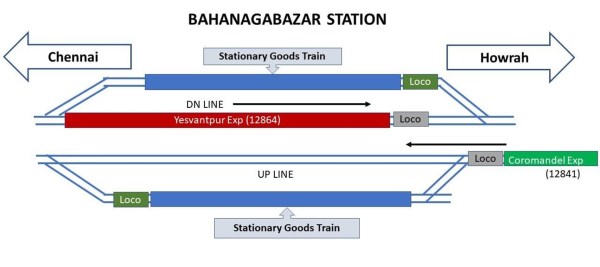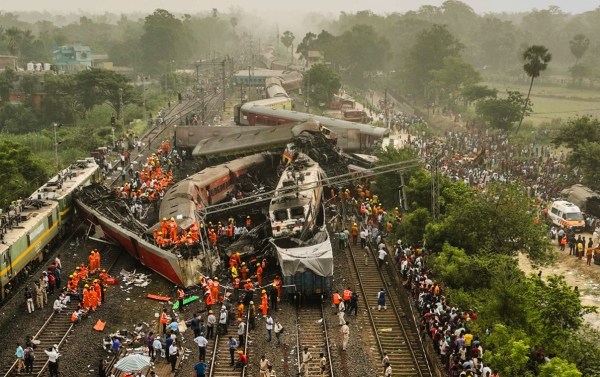How did the Odisha train crash happen? This is what we know so far
Close to 24 hours after the railway accident at Odisha’s Bahanaga Bazar station, it remains unclear how the tragedy occurred. The Railways have issued a sketchy official statement with very few details, even as the death toll has climbed to 288, with more than 800 injured.

This is what we know about the crash so far, based on the information provided by sources in the Railways. The full picture will likely be clear only after an official inquiry into the incident. A more detailed statement from the Railways is awaited.
Where and when did the accident happen?
The spot of the crash is a little before Bahanaga Bazar station in Odisha’s Balasore district, which is part of the Kharagpur railway division of South Eastern Railway. Three trains were involved — two passenger trains going in opposite directions, and a goods train that was stationary.
Illustration of the spot where the accident took place.
The first train, the 12841 Coromandel Express, had started from Shalimar station in Kolkata/Howrah and was headed to Chennai. It had crossed Kharagpur and Balasore, and its next stop would have been Bhadrak. The train was running almost exactly on time, and would have crossed Bahanaga Bazar (without stopping) at 7.01 pm.
How are the tracks laid out at Bahanaga Bazar?
There is the Up Main Line (towards Chennai), the Down Main line (towards Howrah), and two loop lines on the two sides. The purpose of a loop is to park a train on the side so that the main line is left clear for a faster or more important train.
As the Coromandel approached, the loop line was occupied by a goods train going in the same (Up) direction. The Coromandel was supposed to go past it on the main line.
So what went wrong here?
According to the short brief on the accident issued by the Railways, “Up Train No. 12841…passing through Up Main Line…dashed with stationary Goods Train in Up Loop Line… The train was going at full speed across the station as it was not supposed to stop at the station…”

It is obvious from the brief that the Coromandel, instead of going past the goods train on the main line, entered the loop and smashed into the goods train from the rear. Pictures from the spot show the Coromandel’s locomotive perched atop the goods train.
Image of the railway accident at Odisha’s Bahanaga Bazar station. (Express photo)
But how could that happen?
Locomotive drivers are guided by signals, not so much by what they see on the tracks, especially in the dark. While details will be known after the inquiry, the Railways are looking at the possibility of a signalling error, sources have told The Indian Express.
A multi-disciplinary joint inspection by supervisors has concluded that a green signal was given to the Coromandel to pass through on the designated main line, and then the signal was taken off. The train entered the loop line, and rammed into the goods train.
“We…after careful observation, came to the conclusion that signal was given, and taken off, for Up main line for 12841, but this train entered into Up loop line and dashed with goods train which was on Up loop line and derailed,” says a note prepared by the joint inspection team.
Could the driver have done something to prevent the crash?
Officials in the Railways are looking into signalling error/ failure as well as issues to do with the driver — known as the “loco pilot” in the Railways, a top source said.
However, it must be noted that trains are gigantic masses of steel, hauled by enormously powerful engines. The railway brief says the Coromandel was going at “full speed”, which could be around 100 km/hr. At that speed, even after the application of emergency brakes, a train would not come to a halt before perhaps a couple of kilometres.
So where does the third train come into the picture?
At the same time as the Coromandel hit the goods train, a third train, the 12864 Sir M Visvesvaraya Terminal Bengaluru-Howrah Express, was going past on the adjacent Down main line, headed towards Howrah (in the opposite direction). Most of this train had already crossed the point of the accident when the Coromandel crashed into the goods train. However, the last few coaches were impacted. These derailed — either because they were hit by coaches of the Coromandel that toppled on to them, or because of the shock waves that could have passed through the ground and the tracks.


































































